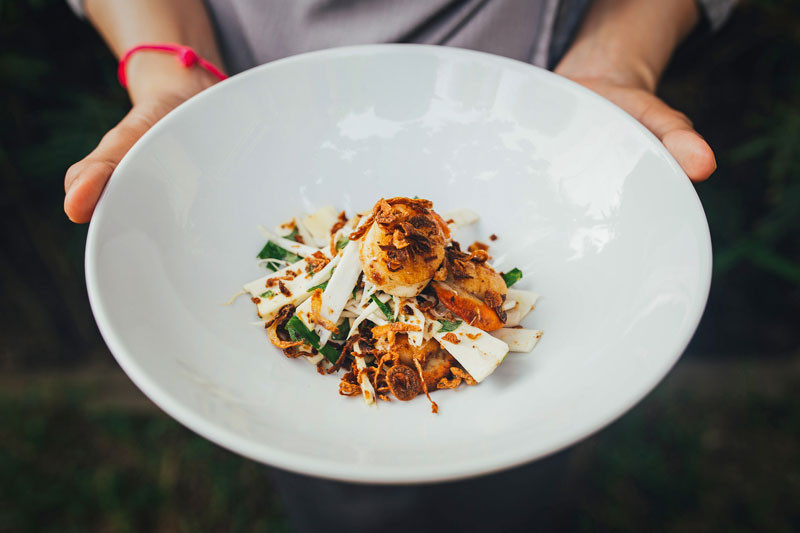Two weeks ago, French chef Joannes Riviere heard a rumor that ripe, locally-grown tomatoes were available somewhere in Siem Reap province’s Banteay Srei district.
Since locally-grown tomatoes are usually only available in December and January, he was rather excited. The chef decided “to track them down.”

But as of Wednesday, Mr. Riviere had not managed to locate the grower. Had he found him, he said, he would have created a recipe around those fresh tomatoes, maybe pairing them with Mekong River lobster, he said.
“The true luxury in the dish would not have been the lobster, but Cambodia’s tomatoes,” he said. “It really becomes a game to locate new vegetables…new varieties and what is in season.”
At Cuisine Wat Damnak, his Cambodian restaurant in Siem Reap City, the five-course tasting menu is rewritten every week—except for desserts—based on what fresh products are available at the market.
For instance, heart of palm recently became available at a market stall where Mr. Riviere shops daily. Someone probably had to cut down coconut trees due to roadwork or a construction project, so the hearts—the inner core of the trunk—were suddenly available, he said.
“What I find fascinating about coconut-tree hearts is the fact that it is somewhat of an ‘accidental vegetable’ and the time it takes to produce it: A coconut tree like this took 20 years to grow,” he said. “So this really is an incredible luxury.”
Mr. Riviere paired this very special vegetable with another rare product: scallops from Koh Kong province that are only available for a couple of months a year.
The recipe in itself was rather simple, but the ingredients made it unique, he said.
Mr. Riviere quickly cooked the scallops in a very hot pan with a touch of Cambodian lard and mixed them in a bowl with thin slices of heart of palm. He added a dressing of palm sugar, lemon juice and specially made fish sauce from Kampot City.
In Cambodian cuisine, this type of salad would usually call for peanuts. But because it was made with coconut-tree heart, Mr. Riviere used roasted coconut pieces instead, plus a few fried shallots.
“This is a good example of what we produce here in terms of seasonality and products,” he said.
Embracing nature’s cycle was something the 36-year-old chef learned as a child.
“My parents were into organic-market gardening in the 1970s before organic growing was in fashion,” he said. His family later opened a restaurant, where Mr. Riviere worked on his school holidays. But still, he focused on studying music and playing the organ before turning to cooking.
After working for two years as a pastry chef in the U.S., Mr. Riviere moved to Cambodia in 2003 and volunteered for Sala Bai, a French-NGO hospitality school that offers free training to students from poor neighborhoods in Siem Reap.
“As soon as I arrived, I had to jump into Cambodian cuisine because I had to write a recipe book for Sala Bai’s students, which led me to do research,” he said.
In 2005, he joined the staff of Hotel de la Paix—now the Park Hyatt Siem Reap—as a Cambodian cuisine sous-chef and later became executive chef.
He left at the end of 2010 and opened Cuisine Wat Damnak with his wife Carole in 2011. The restaurant was named one of Asia’s 50 best in 2015 by Diners Club Asia, a list voted on by chefs and food critics in the region.
“We were really the first [in Siem Reap City] to offer a menu that changed every day, a cuisine…with seasonal produce, wild fish and truly local products,” he said.
Fluent in Khmer, Mr. Riviere said he loves to talk food with Cambodians he meets throughout the country.
“I believe there is a vast repertoire in Cambodia of dishes and products, recipes and techniques that are extremely underestimated,” he said.